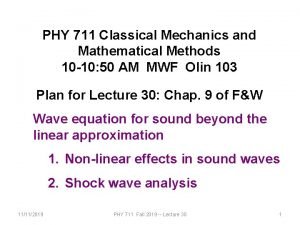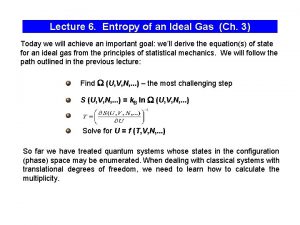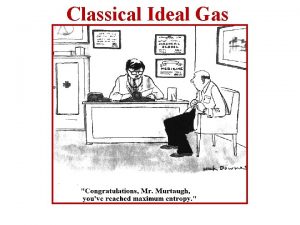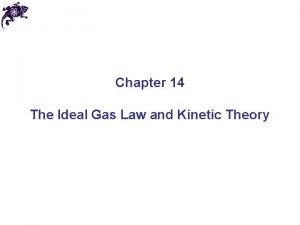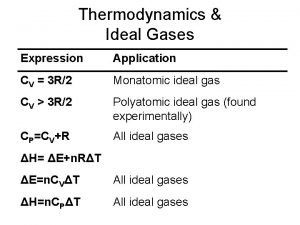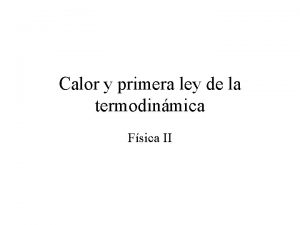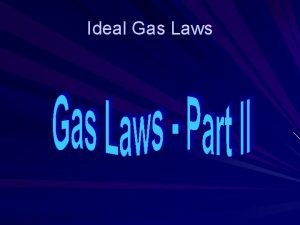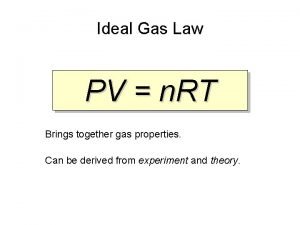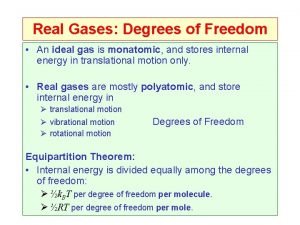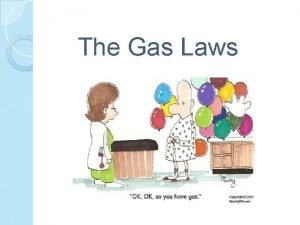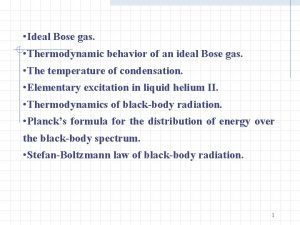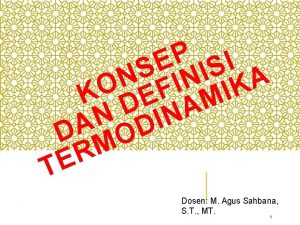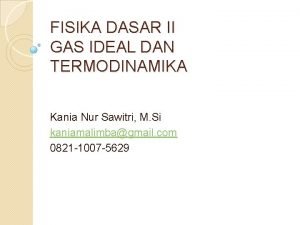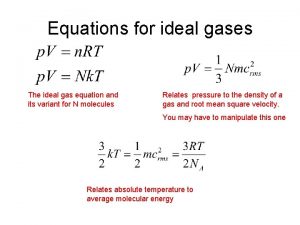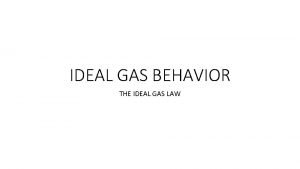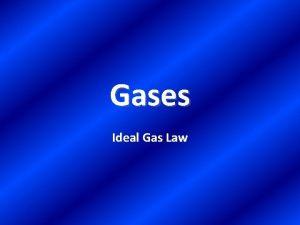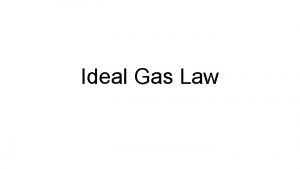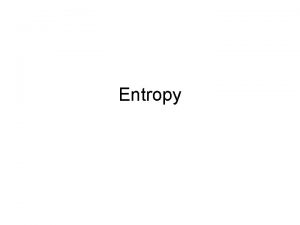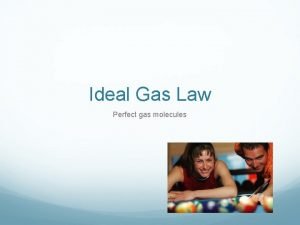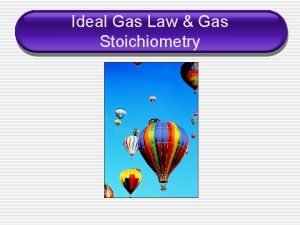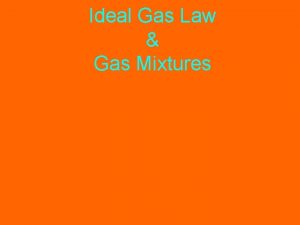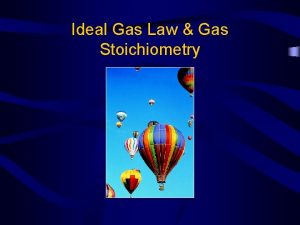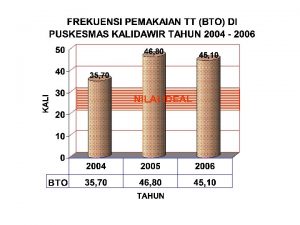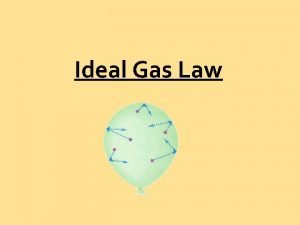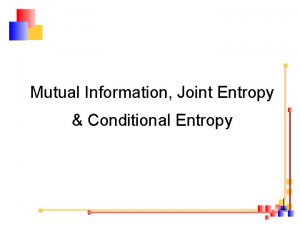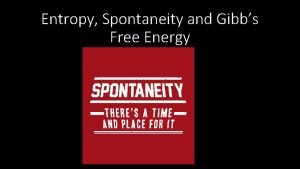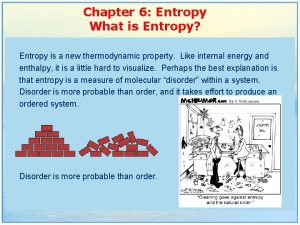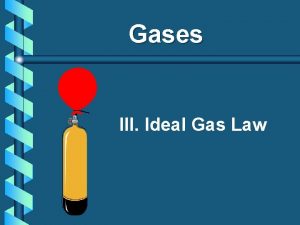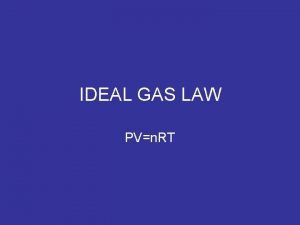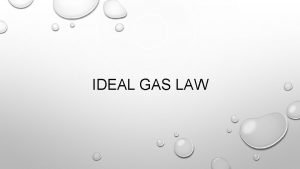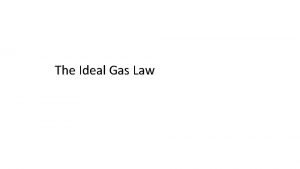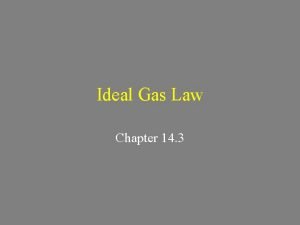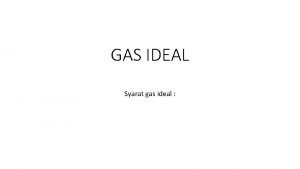Lecture 6 Entropy of an Ideal Gas Ch























- Slides: 23

Lecture 6. Entropy of an Ideal Gas (Ch. 3) Today we will achieve an important goal: we’ll derive the equation(s) of state for an ideal gas from the principles of statistical mechanics. We will follow the path outlined in the previous lecture: Find (U, V, N, . . . ) – the most challenging step S (U, V, N, . . . ) = k. B ln (U, V, N, . . . ) Solve for U = f (T, V, N, . . . ) So far we have treated quantum systems whose states in the configuration (phase) space may be enumerated. When dealing with classical systems with translational degrees of freedom, we need to learn how to calculate the multiplicity.

Multiplicity for a Single particle - is more complicated than that for an Einstein solid, because it depends on three rather than two macro parameters (e. g. , N, U, V). Example: particle in a onedimensional “box” -L L The total number of ways of filling up the cells in phase space is the product of the number of ways the “space” cells can be filled times the number of ways the “momentum” cells can be filled px The total number of microstates: -L L x px -px The number of microstates: x Q. M. Quantum mechanics (the uncertainty principle) helps us to numerate all different states in the configuration (phase) space:

Multiplicity of a Monatomic Ideal Gas (simplified) For a molecule in a three-dimensional box: the state of the molecule is a point in the 6 D space - its position (x, y, z) and its momentum (px, py, pz). The number of “space” microstates is: For N molecules: There is some momentum distribution of molecules in an ideal gas (Maxwell), with a long “tail” that goes all the way up to p = (2 m. U)1/2 (U is the total energy of the gas). However, the momentum vector of an “average” molecule is confined within a sphere of radius p ~ (2 m. U/N)1/2 (U/N is the average energy per molecule). Thus, for a single “average” molecule: The total number of microstates for N molecules: However, we have over-counted the multiplicity, because we have assumed that the atoms are distinguishable. For indistinguishable quantum particles, the result should be divided by N! (the number of ways of arranging N identical atoms in a given set of “boxes”): n p

pz More Accurate Calculation of p Momentum constraints: py px 1 particle 2 particles - The accessible momentum volume for N particles = the “area” of a 3 N-dimensional hypersphere p N =1 The reason why m matters: for a given U, a molecule with a larger mass has a larger momentum, thus a larger “volume” accessible in the momentum space. Monatomic ideal gas: (3 N degrees of freedom) f N- the total # of “quadratic” degrees of freedom

Entropy of an Ideal Gas the Sackur. Tetrode equation Monatomic ideal gas: an average volume an average energy per molecule In general, for a gas of polyatomic molecules: f 3 (monatomic), 5 (diatomic), 6 (polyatomic)

Problem Two cylinders (V = 1 liter each) are connected by a valve. In one of the cylinders – Hydrogen (H 2) at P = 105 Pa, T = 200 C , in another one – Helium (He) at P = 3· 105 Pa, T=1000 C. Find the entropy change after mixing and equilibrating. For each gas: The temperature after mixing: H 2 : He :

Entropy of Mixing Consider two different ideal gases (N 1, N 2) kept in two separate volumes (V 1, V 2) at the same temperature. To calculate the increase of entropy in the mixing process, we can treat each gas as a separate system. In the mixing process, U/N remains the same (T will be the same after mixing). The parameter that changes is V/N: if N 1=N 2=1/2 N , V 1=V 2=1/2 V The total entropy of the system is greater after mixing – thus, mixing is irreversible.

Gibbs Paradox - applies only if two gases are different ! If two mixing gases are of the same kind (indistinguishable molecules): Stotal = 0 because U/N and V/N available for each molecule remain the same after mixing. Quantum-mechanical indistinguishability is important! (even though this equation applies only in the low density limit, which is “classical” in the sense that the distinction between fermions and bosons disappear.

Problem Two identical perfect gases with the same pressure P and the same number of particles N, but with different temperatures T 1 and T 2, are confined in two vessels, of volume V 1 and V 2 , which are then connected. find the change in entropy after the system has reached equilibrium. - prove it! at T 1=T 2, S=0, as it should be (Gibbs paradox)

An Ideal Gas: from S(N, V, U) - to U(N, V, T) Ideal gas: (f. N degrees of freedom) - the “energy” equation of state - in agreement with the equipartition theorem, the total energy should be ½k. BT times the number of degrees of freedom. The heat capacity for a monatomic ideal gas:

Partial Derivatives of the Entropy We have been considering the entropy changes in the processes where two interacting systems exchanged thermal energy but the volume and the number of particles in these systems were fixed. In general, however, we need more than just one parameter to specify a macrostate, e. g for an ideal gas When all macroscopic quantities S, V, N, U are allowed to vary: We are familiar with the physical meaning only one partial derivative of entropy: Today we will explore what happens if we let the other two parameters (V and N) vary, and analyze the physical meaning of the other two partial derivatives of the entropy:

Thermodynamic Identity for d. U(S, V, N) if monotonic as a function of U (“quadratic” degrees of freedom!), may be inverted to give pressure compare with chemical potential shows how much the system’s energy changes when one particle is added to the system at fixed S and V. The chemical potential units – J. - the so-called thermodynamic identity for U This holds for quasi-static processes (T, P, are well-define throughout the system).

The Exact Differential of S(U, V, N) The coefficients may be identified as: Again, this holds for quasi-static processes (T and P are well defined). Type of interaction Exchanged quantity Governing variable thermal energy temperature mechanical volume pressure diffusive particles chemical potential Formula connection between thermodynamics and statistical mechanics

Mechanical Equilibrium and Pressure UA , V A , N A UB , V B , N B Let’s fix UA, NA and UB, NB , but allow V to vary (the membrane is insulating, impermeable for gas molecules, but its position is not fixed). Following the same logic, spontaneous “exchange of volume” between sub-systems will drive the system towards mechanical equilibrium (the membrane at rest). The equilibrium macropartition should have the largest (by far) multiplicity (U, V) and entropy S (U, V). - the sub-system with a smaller volume-per-molecule (larger P at the same T) will have a larger S/ V, it will expand at the expense of the other sub-system. In mechanical equilibrium: S AB SA SB VAeq VA The stat. phys. definition of pressure: - the volume-per-molecule should be the same for both sub-systems, or, if T is the same, P must be the same on both sides of the membrane.

The “Pressure” Equation of State for an Ideal Gas Ideal gas: (f. N degrees of freedom) The “energy” equation of state (U T): The “pressure” equation of state (P T): - we have finally derived the equation of state of an ideal gas from first principles!

Quasi-Static Processes (quasi-static processes with fixed N) (all processes) Thus, for quasi-static processes : P Comment on State Functions : - is an exact differential (S is a state function). Thus, the factor 1/T converts Q into an exact differential for quasi-static processes. Quasistatic adiabatic ( Q = 0) processes: V isentropic processes The quasi-static adiabatic process with an ideal gas : - we’ve derived these equations from the 1 st Law and PV=RT On the other hand, from the Sackur-Tetrode equation for an isentropic process :

Problem: (all the processes are quasi-static) (a) Calculate the entropy increase of an ideal gas in an isothermal process. (b) Calculate the entropy increase of an ideal gas in an isochoric process. You should be able to do this using (a) Sackur-Tetrode eq. and (b) Let’s verify that we get the same result with approaches a) and b) (e. g. , for T=const): Since U = 0, (Pr. 2. 34)

Problem: A body of mass M with heat capacity (per unit mass) C, initially at temperature T 0+ T, is brought into thermal contact with a heat bath at temperature T 0. . (a) Show that if T<<T 0, the increase S in the entropy of the entire system (body+heat bath) when equilibrium is reached is proportional to ( T)2. (b) Find S if the body is a bacteria of mass 10 -15 kg with C=4 k. J/(kg·K), T 0=300 K, T=0. 03 K. (c) What is the probability of finding the bacteria at its initial T 0+ T for t =10 -12 s over the lifetime of the Universe (~1018 s). (a) (b)

Problem (cont. ) (b) for the (non-equilibrium) state with Tbacteria = 300. 03 K is greater than in the equilibrium state with Tbacteria = 300 K by a factor of The number of “ 1 ps” trials over the lifetime of the Universe: Thus, the probability of the event happening in 1030 trials:

An example of a non-quasistatic adiabatic process Caution: for non-quasistatic adiabatic processes, S might be non-zero!!! P 2 S = const along the isentropic line 2* Pr. 3. 32. A non-quasistatic compression. A cylinder with air (V = 10 -3 m 3, T = 300 K, P =105 Pa) is compressed (very fast, non-quasistatic) by a piston (S = 0. 01 m 2, F = 2000 N, x = 10 -3 m). Calculate W, Q, U, and S. 1 Vf Vi V quasistatic adiabatic isentropic holds for all processes, energy conservation quasistatic, T and P are welldefined for any intermediate state Q = 0 for both non-quasistatic adiabatic The non-quasistatic process results in a higher T and a greater entropy of the final state.

Direct approach: adiabatic quasistatic isentropic adiabatic non-quasistatic

P 2 U = Q = 1 J To calculate S, we can consider any quasistatic process that would bring the gas into the final state (S is a state function). For example, along the red line that coincides with the adiabat and then shoots straight up. Let’s neglect small variations of T along this path ( U << U, so it won’t be a big mistake to assume T const): 1 Vf Vi V The entropy is created because it is an irreversible, non -quasistatic compression. P 2 U = Q = 2 J For any quasi-static path from 1 to 2, we must have the same S. Let’s take another path – along the isotherm and then straight up: isotherm: 1 Vf Vi V “straight up”: Total gain of entropy:

P The inverse process, sudden expansion of an ideal gas (2 – 3) also generates entropy (adiabatic but not quasistatic). Neither heat nor work is transferred: W = Q = 0 (we assume the whole process occurs rapidly enough so that no heat flows in through the walls). 2 3 1 Vf Vi V Because U is unchanged, T of the ideal gas is unchanged. The final state is identical with the state that results from a reversible isothermal expansion with the gas in thermal equilibrium with a reservoir. The work done on the gas in the reversible expansion from volume Vf to Vi: The work done on the gas is negative, the gas does positive work on the piston in an amount equal to the heat transfer into the system Thus, by going 1 2 3 , we will increase the gas entropy by
 Ideal gas entropy
Ideal gas entropy Pzmore
Pzmore Tds relation
Tds relation Differences between ideal gas and real gas
Differences between ideal gas and real gas Computational fluid dynamics
Computational fluid dynamics Derive ideal gas equation
Derive ideal gas equation Difference between ideal gas and real gas
Difference between ideal gas and real gas An ideal gas is an imaginary gas
An ideal gas is an imaginary gas 01:640:244 lecture notes - lecture 15: plat, idah, farad
01:640:244 lecture notes - lecture 15: plat, idah, farad Ideal solution and non ideal solution
Ideal solution and non ideal solution Classical ideal gas
Classical ideal gas Energy of ideal gas
Energy of ideal gas Example of ideal gas
Example of ideal gas Cv of an ideal gas
Cv of an ideal gas Cambio de energia interna en un proceso adiabatico
Cambio de energia interna en un proceso adiabatico Law of combining volumes
Law of combining volumes N=rt/pv
N=rt/pv Mlk poem generator
Mlk poem generator Degree of freedom of gases
Degree of freedom of gases Kenitic molecular theory
Kenitic molecular theory Thermodynamic behaviour of ideal bose gas
Thermodynamic behaviour of ideal bose gas Suhu tiga mol suatu gas ideal
Suhu tiga mol suatu gas ideal Sifat gas ideal
Sifat gas ideal Ideal gas law formula
Ideal gas law formula
